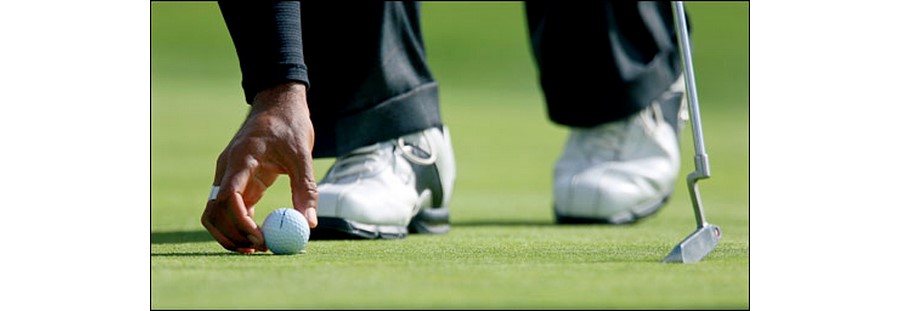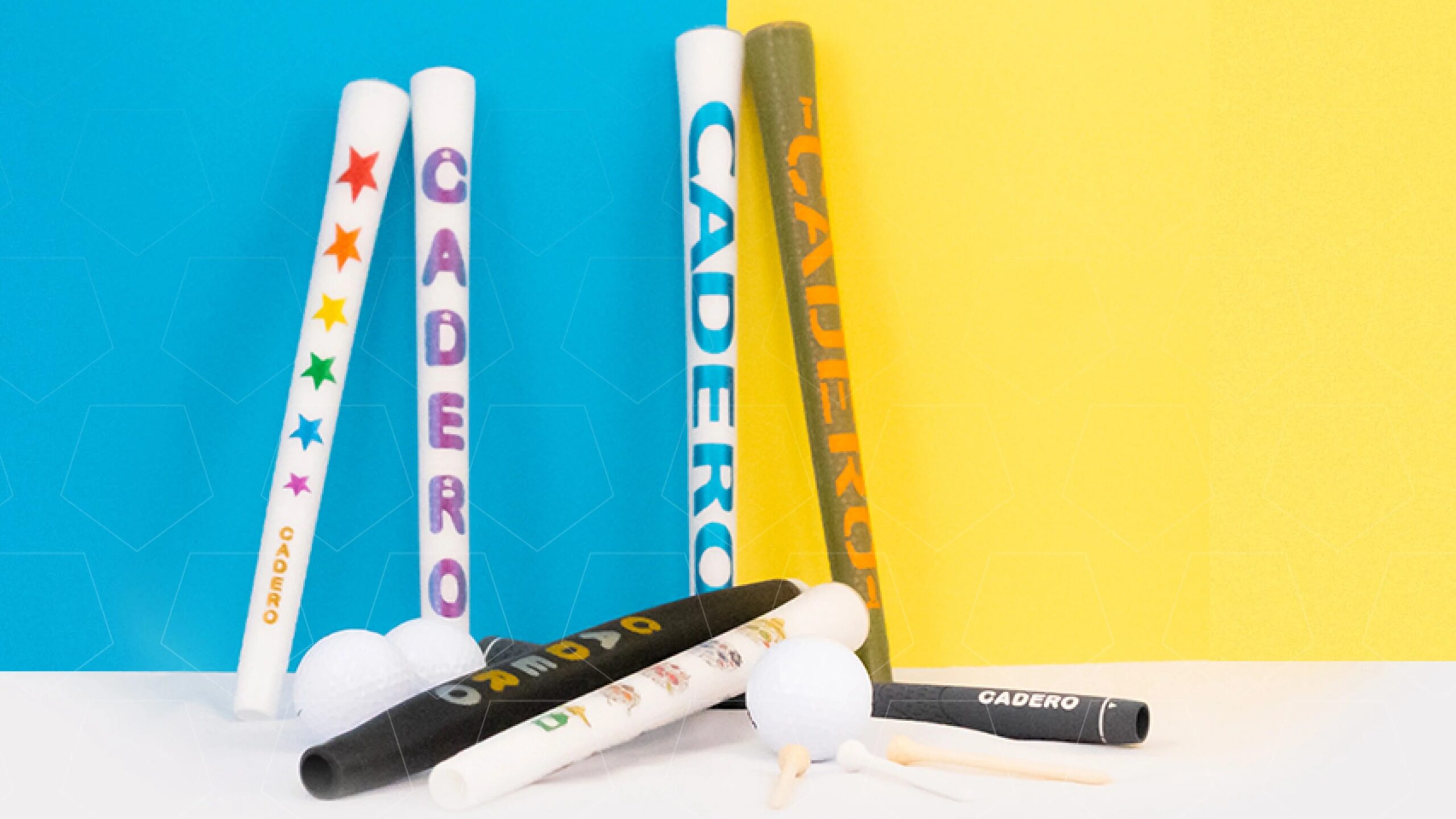Visual perception is everything when it comes to reading and feeling the line and pace of every putt
In order to achieve consistency on the putting green, a player’s perceptual motor skills must be fully engaged with the ‘read’ of the putt when he focuses on his ball-roll line. Good visual health, creative visualisation skills and obtaining reliable depth and distance judgment information are crucial to great putting. You must be able to read the slope of a green accurately, see your putting line clearly, and trust what your eyes are telling you before you step into the address position and stroke the ball. This is because putting is essentially a visual and tactile task. Your eyes provide you with the majority of vital information that predominately drives your body’s motor system. The impulse your eyes provide is the signal to your brain that transmits the feeling impulse to your hands and fingers.
If you possess normal human vision, your eyes provide you with over 85% of all the sensory information which directs your golf and putting performance. No other sensory system of the body has such a major impact on human performance as the visual system. Being able to utilise your visual system accurately can help you perform more effectively when it is time to play, and this is especially true on the putting green.
Putting with a child's eyes
It is important that you understand that your eyes lead your body and not the other way around. This may be the reason that young children are such naturally good putters. They just merely look at where they want the ball to go and then react to that target image. They are reacting to the visual stimulus that they see with their eyes and they respond to it.
Putting in this way keeps the whole process quite simple.When young children putt, there usually isn’t any worry about distance judgment, mechanics or stroke analysis, or even about making or missing.
The truth is probably this: young children are so busy just looking and reacting to the target that they don’t have the time or the energy to mess themselves up. The trouble most average golfers have is that they do not use their eyes properly or gain enough reliable information when they are putting.
In truth, average or poor putters don’t “see enough” vital information when they are on the green or they don’t trust the information that their eyes provide them with. They are prone to overanalyse and manipulate their stroke because they are either confused by the read or they haven’t processed the information correctly.

Kids don’t think about what they are trying to achieve – they simply stand up, look at the target and trust their instincts to help them find it.
The eye of the Tiger
If you watch a great putter, you can observe the intense focus in his eyes. Tiger Woods is the ultimate example of a player who displays and possesses an intense focus as he prepares to putt. His intensity and concentrated focus is evident in his “icy stare” when he is on the green. Tiger uses his visual focus to direct his mind and body for specific action. As Gary Player says: “You feel a golf course with your eyes. You play golf with your eyes. The average player just doesn’t realise this. Your eyes tell you everything about the wind, the greens, everything.”

However, you do not have to be Tiger Woods to putt great or read greens well. Sports vision researchers tell us that many touring professionals do have great visual skills, but not any more or less than the average population of normal athletes or everyday people.What the touring professionals do possess is an ability to synthesize this visual information and use it in an efficient manner to help them feel confident about their green reading and the decision about where they want the ball to roll and how hard to hit it. Part of the process in becoming a great putter is learning to see the proper break in the green and putt the ball along that line.
You are what you see
It is extremely important to remember that the proper break in the green is what you see, not in what someone else is seeing or telling you where to putt the ball. Your putting prowess is largely determined by your overall putting philosophy, which may change due to the situation you are faced with or the conditions of the greens.
This means that for extremely fast greens, you may want to take a more conservative approach and roll the ball gently at “drop speed” at the hole. Or, if you play slower greens, you may take a more aggressive attitude and roll the ball into the hole so that it always has a chance to reach the hole or go by it a short distance. Only you know how hard you are going to hit the ball and what line you want the ball to roll on. No one else can really and truly say that the line they see in their eyes is the line you must putt the ball on. This is why touring professionals generally only ask their caddies for an insight to where the ball may move. It is not uncommon for many touring professionals not to ask their caddies for any information because they may receive information overload or input which may alter their own decision-making process.

Also, only you know how hard you are going to hit the ball at the moment of impact. This means that you may play for more break if you want to hit the ball softly and allow for it to die or drop softly into the hole. Or you may hit it firmly and have the ball roll at an aggressive pace to negate the breaks or imperfections on the green surrounding the hole. The possibilities are endless for how you can putt the ball. This is why it is so important that you make a good decision before you step up to the ball and know exactly how hard you want to hit it before you formally address it.
You are what you read
Putting on fast, sloping greens creates a perceptual-motor task that often intimidates and frustrates many golfers. The key to becoming an accomplished putter is that you must first understand what your eyes see when you step on to the green. You need to learn to read greens well, assess and make the appropriate changes for speed which vary from green to green, and know how hard to stroke the ball. These keys are essential to becoming a consistent and confident putter.
As in the full swing, putting needs to be kept simple, and what is simpler than looking at your target, focusing on the ball and just stroking away? If you focus on your line with intention and purpose and have done your green-reading homework, you give yourself the best chance of rolling the ball into the hole. The key to keeping it simple is to use your eyes effectively and to trust your read and feel for the hit of the putt.
Six visual keys for putting success
The following six steps are simple ways in which you can use your eyes to provide you with greater information and become better at reading greens, enable you to make clearer decisions and, ultimately, sink more putts.
1. Obtain as much information about the putt as possible by walking around it from different angles and seeing where the apex of the break occurs. Remember that your first look or instinctive hunch about where the ball wants to go is usually your best. Sometimes players get too analytical and psyche themselves out of the correct line when they had it right the first time they viewed it. After you see where the ball needs to go, get down low and behind the ball to obtain the best perspective. Four to five feet behind the ball is generally a good spot to read the ball-line from. A good example of someone who does this well is Nick Dougherty. He gets down low so that he can see the undulations and slopes of the green and ball/target line more clearly.
2. Make a firm decision where you want to start the ball and where it needs to go in order to follow the break into the hole. Commit to this decision and do not alter it when moving into the ball.
3. When moving into the ball, do not lose your perspective when standing up and moving into the address position. Stay committed to your ‘lowview’ perspective and do not allow yourself to doubt or mistrust your read when above the ball. Staying committed to this perspective is a vital key to making more putts
4. Aim your putter squarely along your ball-roll line. Use your eyes to track (move up and down the ball line to and from the hole) and gain an appreciation of the total distance the ball needs to travel.
5. Upon your last look at the hole or apex spot, move your eyes back to the ball and putt without delay. Many putts are mishit and missed due to golfers standing too long over the ball and allowing pressure to build and thus their target (or hole) awareness fades.
6. Watch the ball roll all the way into the cup and hold your finish. If the ball goes into the hole, you have a visual success picture to put into your memory bank. If the putt fails to fall and misses, it becomes vital that you watch what it does as it rolls by the hole. Most short comeback putts are missed due to a golfer not viewing the first putt until it stopped. By watching your putt slide by the hole, you have a better idea of what it will do on the next putt.
Originally published in 2014



